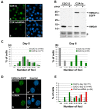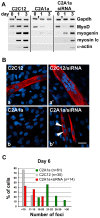HMGA1 down-regulation is crucial for chromatin composition and a gene expression profile permitting myogenic differentiation
- PMID: 20701767
- PMCID: PMC2928187
- DOI: 10.1186/1471-2121-11-64
HMGA1 down-regulation is crucial for chromatin composition and a gene expression profile permitting myogenic differentiation
Abstract
Background: High mobility group A (HMGA) proteins regulate gene transcription through architectural modulation of chromatin and the formation of multi-protein complexes on promoter/enhancer regions. Differential expression of HMGA variants has been found to be important for distinct differentiation processes and deregulated expression was linked to several disorders. Here we used mouse C2C12 myoblasts and C2C12 cells stably over-expressing HMGA1a-eGFP to study the impact of deregulated HMGA1 expression levels on cellular differentiation.
Results: We found that induction of the myogenic or osteogenic program of C2C12 cells caused an immediate down-regulation of HMGA1. In contrast to wild type C2C12 cells, an engineered cell line with stable over-expression of HMGA1a-eGFP failed to differentiate into myotubes. Immunolocalization studies demonstrated that sustained HMGA1a-eGFP expression prevented myotube formation and chromatin reorganization that normally accompanies differentiation. Western Blot analyses showed that elevated HMGA1a-eGFP levels affected chromatin composition through either down-regulation of histone H1 or premature expression of MeCP2. RT-PCR analyses further revealed that sustained HMGA1a expression also affected myogenic gene expression and caused either down-regulation of genes such as MyoD, myogenin, Igf1, Igf2, Igfbp1-3 or up-regulation of the transcriptional repressor Msx1. Interestingly, siRNA experiments demonstrated that knock-down of HMGA1a was required and sufficient to reactivate the myogenic program in induced HMGA1a over-expressing cells.
Conclusions: Our data demonstrate that HMGA1 down-regulation after induction is required to initiate the myogenic program in C2C12 cells. Sustained HMGA1a expression after induction prevents expression of key myogenic factors. This may be due to specific gene regulation and/or global effects on chromatin. Our data further corroborate that altered HMGA1 levels influence the expression of other chromatin proteins. Thus, HMGA1 is able to establish a specific chromatin composition. This work contributes to the understanding of how differential HMGA1 expression is involved in chromatin organization during cellular differentiation processes and it may help to comprehend effects of HMGA1 over-expression occurring in malign or benign tumours.
Figures







Similar articles
-
Regulatory Axis of miR-195/497 and HMGA1-Id3 Governs Muscle Cell Proliferation and Differentiation.Int J Biol Sci. 2017 Jan 15;13(2):157-166. doi: 10.7150/ijbs.17440. eCollection 2017. Int J Biol Sci. 2017. PMID: 28255268 Free PMC article.
-
Dynamic interaction of HMGA1a proteins with chromatin.J Cell Sci. 2004 Jul 15;117(Pt 16):3459-71. doi: 10.1242/jcs.01160. Epub 2004 Jun 22. J Cell Sci. 2004. PMID: 15213251
-
The Scaffold attachment factor b1 (Safb1) regulates myogenic differentiation by facilitating the transition of myogenic gene chromatin from a repressed to an activated state.Nucleic Acids Res. 2013 Jun;41(11):5704-16. doi: 10.1093/nar/gkt285. Epub 2013 Apr 22. Nucleic Acids Res. 2013. PMID: 23609547 Free PMC article.
-
The High Mobility Group A1 (HMGA1) Transcriptome in Cancer and Development.Curr Mol Med. 2016;16(4):353-93. doi: 10.2174/1566524016666160316152147. Curr Mol Med. 2016. PMID: 26980699 Free PMC article. Review.
-
Molecular mechanism of HMGA1 deregulation in human neuroblastoma.Cancer Lett. 2005 Oct 18;228(1-2):97-104. doi: 10.1016/j.canlet.2005.01.045. Cancer Lett. 2005. PMID: 15923078 Review.
Cited by
-
In Pulmonary Arterial Hypertension, Reduced BMPR2 Promotes Endothelial-to-Mesenchymal Transition via HMGA1 and Its Target Slug.Circulation. 2016 May 3;133(18):1783-94. doi: 10.1161/CIRCULATIONAHA.115.020617. Epub 2016 Apr 4. Circulation. 2016. PMID: 27045138 Free PMC article.
-
Transcriptional Regulation of Glucose Metabolism: The Emerging Role of the HMGA1 Chromatin Factor.Front Endocrinol (Lausanne). 2018 Jul 3;9:357. doi: 10.3389/fendo.2018.00357. eCollection 2018. Front Endocrinol (Lausanne). 2018. PMID: 30034366 Free PMC article. Review.
-
HMGA Genes and Proteins in Development and Evolution.Int J Mol Sci. 2020 Jan 19;21(2):654. doi: 10.3390/ijms21020654. Int J Mol Sci. 2020. PMID: 31963852 Free PMC article. Review.
-
Prioritizing transcriptional factors in gene regulatory networks with PageRank.iScience. 2020 Dec 30;24(1):102017. doi: 10.1016/j.isci.2020.102017. eCollection 2021 Jan 22. iScience. 2020. PMID: 33490923 Free PMC article.
-
PKCε as a novel promoter of skeletal muscle differentiation and regeneration.Exp Cell Res. 2015 Nov 15;339(1):10-9. doi: 10.1016/j.yexcr.2015.09.017. Epub 2015 Sep 30. Exp Cell Res. 2015. PMID: 26431586 Free PMC article.
References
-
- Catez F, Hock R. Binding and interplay of HMG proteins on chromatin: Lessons from live cell imaging. Biochim Biophys acta. 2010;1799:15–27. - PubMed
-
- Reeves R, Beckerbauer L. HMGI/Y proteins: flexible regulators of transcription and chromatin structure. Biochim Biophys Acta. 2001;1519:13–29. - PubMed
Publication types
MeSH terms
Substances
LinkOut - more resources
Full Text Sources
Miscellaneous

